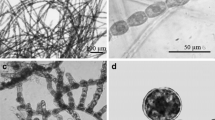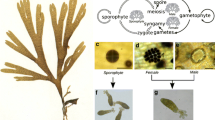Abstract
The effects of daylength, irradiance and spore settlement density on the growth, maturation and sporophyte production of Undaria pinnatifida (Harvey) Suringar gametophytes were examined using a factorial experimental design in culture. The growth of Undaria gametophytes increased with increasing daylength (8, 12 and 16 h), but the maximum fertility occurred at a daylength of 12 h followed by 8 and 16 h. Gametophytes grew better at the 16 h daylength under the same mean daily irradiance (MDI) of 20 μmol photons m−2 s−1. However, the fertility was higher at the short daylength (8 h), indicating that the maturation of U. pinnatifida gametophytes is influenced by daylength rather than by the MDI. Vegetative growth and sporophyte production of gametophytes were better at 60 μmol photons m−2 s−1 than at 30 μmol photons m−2 s−1 under a 8:16 h LD (Light: Dark) cycle, and their growth and maturation were density-dependant in 16 and 12 h daylength, respectively. These results suggest that the U. pinnatifida gametophytes require a certain amount of light for the growth and reproduction, and intraspecific competition occurred under the optimal growth and maturation conditions. However, the sporophyte recruits per unit has been enhanced with increasing spore settlement density at 8 and 12 h daylengths indicating that high settlement density gives a benefit for maintaining population, even though the sporophyte production of each female plant is inhibited. In conclusion, the vegetative growth, reproduction and sporophyte production of U. pinnatifida gametophytes are retarded at a low irradiance above growth saturation and a high settlement density, and are determined by daylength.
Similar content being viewed by others
References
Akiyama K (1965) Studies of ecology and culture of Undaria pinnatifida (Harv.) Sur. II. Environmental factors affecting the growing and maturation of gamtophyte. Bull. Tohoku Reg. Fish. Res. Lab. 25: 143–170.
Akiyama K, Kurogi M (1982) Cultivation of Undaria pinnatifida (Harvey) Suringar, the decrease in crops from natural plants following crop increase from cultivation. Bull. Tohoku Reg. Fish. Res. Lab. 44: 91–100.
Castric-Fey A, Beaupoil C, Bouchain J, Pradier E, L'Hardy-Halos MTh (1999) The introduced alga Undaria pinnatifida (Laminariales, Alariaceae) in the rocky shore ecosystem of the St Malo area: Growth rate and longevity of the sporophyte. Bot. Mar. 42: 83–96.
Cremades J, Salinas JM, Granja A, Barbara I, Veiga AJ, Perez-Cirera JL, Fuertes C (1997) Influence of the culture factors in the viability and development of Undaria pinnatifida (Laminariales, Phaeophyta): Fouling, seedling-size and adaptation periods before sowing. Nova Acta Cient. Compostelana 7: 29–40.
Chapman ARO, Burrows EM (1970) Experimental investigations into the controlling effects of light conditions on the development and growth of Desmarestia aculeata (L.) Lamour. Phycologia 9: 103–108.
Deysher LE, Dean TA (1986) In situ recruitment of sporophytes of the giant kelp, Macrocystis pyrifera (L.) C.A. Agardh: Effects of physical factors. J. Exp. Mar. Biol. Ecol. 103: 41–63.
Fang TC, Jixun D, Dengoin C (1982) Parthenogenesis and the genetic properties of parthenosporophytes of Undaria pinnatifida. Acta Oceanol. Sinica 1: 107–111.
Hicks CR (1982) Fundamental concepts in the design of experiments, 3rd ed., Holt, Rinehart and Winston, New York, NY, p. 425.
Hoffmann AJ, Santelices B (1982) Effects of light intensity and nutrients on gametophytes and gametogenesis of Lessonia nigrescens Bory (Phaeophyta). J. Exp. Mar. Biol. Ecol. 60: 77–89.
Hurlbert SH (1984) Pseudoreplication and the design of ecological field experiments. Ecol. Monogr. 54: 187–211.
Kim YS, Nam KW (1997) Temperature and light responses on the growth and maturation of gametophytes of Undaria pinnatifida (Harvey) Suringar in Korea. J. Korean Fish. Soc. 30: 505–510.
Lobban CS, Harrison PJ (1994) Seaweed Ecology and Physiology. Cambridge University Press, Cambridge, p. 366.
Lüning K (1981) Egg release in gametophytes of Laminaria saccharina: Induction by darkness and inhibition by blue light and U.V. Br. Phycol. J. 16: 379–393.
Lüning K, Dring MJ (1975) Reproduction, growth and photosynthesis of gametophytes of Laminaria saccharina grown in blue and red light. Mar. Biol. 29: 195–200.
Lüning K, Neushul M (1978) Light and temperature demands for growth and reproduction of laminarian gametophytes in southern and central California. Mar. Biol. 45: 297–309.
Morita T, Kurashima A, Maegawa M (2003) Temperature requirements for the growth and maturation of the gametophytes of Undaria pinnatifida and U. undarioides (Laminariales, Phaeophyceae). Phycol. Res. 51: 154–160.
Pang S, Lüning K (2004) Photoperiodic long-day control of sporophyll and hair formation in the brown alga Undaria pinnatifida. J. Appl. Phycol. 16: 83–92.
Provasoli L (1968) Media and prospects for the cultivation of marine algae. In Watanabe A, Hottori A (eds), Cultures and Collections of Algae. Proceedings of the US-Japan Conference, Hakone, September 1966. Japanese Society of Plant Physiologists, Tokyo, pp. 63–75.
Reed DC (1990) The effects of variable settlement and early competition on patterns of kelp recruitment. Ecology 71: 776–787.
Reed DC, Neushul M, Ebeling AW (1991) Role of settlement density on gametophyte growth and reproduction in the kelps Pterygophora californica and Macrocystis pyrifera (Phaeophyceae). J. Phycol. 27: 361–366.
Saito Y (1956a) An ecological study of Undaria pinnatifida Sur. I. On the influence of environmental factors upon the development of gametophytes. Bull. Jap. Soc. Sci. Fish. 22: 229–234.
Saito Y (1956b) An ecological study of Undaria pinnatifida Sur. II. On the influence of environmental factors upon the maturity of gametophytes and early development of sporophytes. Bull. Jap. Soc. Sci. Fish. 22: 235–239.
Tseng CK, Ren KZ, Wu CY (1959) On the discharge of eggs and spermatozoids of Laminaria japonica and the morphology of the spermatozoids. Kexue Tongbao 4: 129–130.
Underwood AJ (1981) Techniques of analysis of variance in experimental marine biology and ecology. Oceanogr. Mar. Biol. Ann. Rev. 19: 513–605.
Yamanaka R, Akiyama K (1993) Cultivation and utilization of Undaria pinnatifida (wakame) as food. J. Appl. Phycol. 5: 249–253.
Author information
Authors and Affiliations
Corresponding author
Rights and permissions
About this article
Cite this article
Choi, H.G., Kim, Y.S., Lee, S.J. et al. Effects of daylength, irradiance and settlement density on the growth and reproduction of Undaria pinnatifida gametophytes. J Appl Phycol 17, 423–430 (2005). https://doi.org/10.1007/s10811-005-0432-2
Received:
Revised:
Accepted:
Issue Date:
DOI: https://doi.org/10.1007/s10811-005-0432-2




